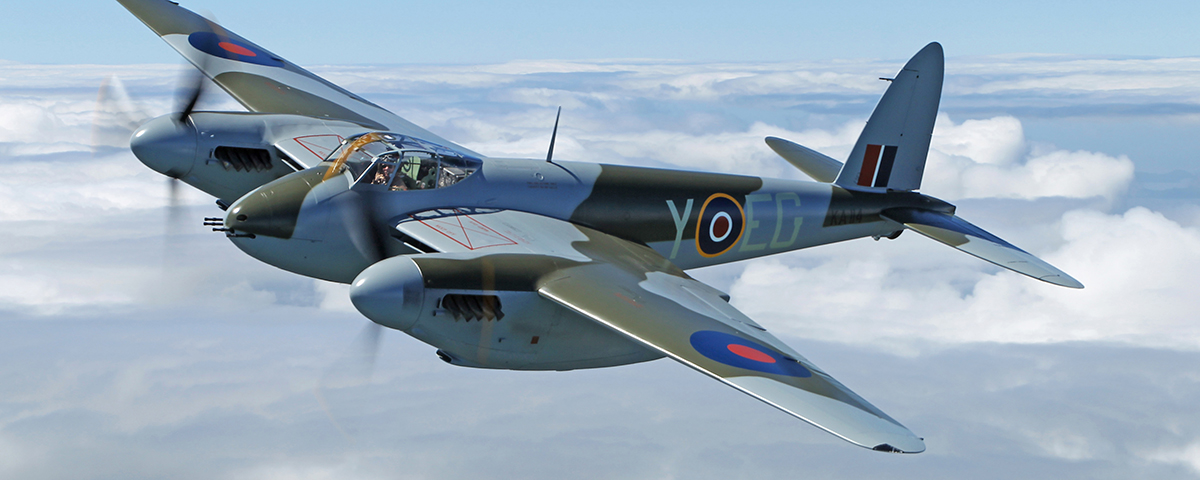Of the hundreds of types of aircraft that flew in World War II, every warbirder could come up with a list of the dozen most iconic. Spitfire, P-51, Zero, Stuka, Me-109, PBY, B-17, Corsair, Lancaster, B-29, Fw-190, Me-262…the candidates are nearly endless, and most lists would differ. But it’s a fair bet that many would include the Timber Terror, the Loping Lumberyard, the Wooden Wonder: the de Havilland Mosquito.
It could be argued that no airplane amassed as remarkable a combat record in so short a time as did the Mosquito. It entered the war relatively late, a year to the day after the Battle of Britain ended, but it debuted with technology and aerodynamics far more advanced than the Spitfire’s. Certainly no airplane flew as many different kinds of missions and performed them as well as the Mosquito, one of the world’s first successful multirole combat aircraft. The Tornado strives to be its successor; the F-35 should be so lucky.
The Mosquito was an unarmed bomber with a crew of two, able to carry a bigger bombload farther than a B-17. It was also a fighter-bomber and a night fighter with an eight-gun nose battery. It was the most productive photoreconnaissance aircraft of the war. A high-speed courier. A weather-recon airplane. A carrier-qualified torpedo bomber (though too late to see combat). A pathfinder and target-marker for heavy bombers. The war’s most effective extreme-low-altitude intruder. A multiengine trainer and a high-speed target tug. A decoy frequently used to convince the Luftwaffe that three or four spoof-raid Mosquitos dropping chaff were a bomber stream of Lancasters.
Many other airplanes did many of these missions, but none did them all. Mosquitos were built in 33 different variants during WWII and seven that were introduced after the war, at a time when everything else with a propeller was being shunted off to reserve and training units.
It seemed such a benighted concept at the time: a bomber with no guns. After all, this was the era of the Flying Fortress, of four-engine aluminum overcasts carrying tons of machine guns, ammunition, ammo cans and belts, complex turret units…and add in the weight of the gunners themselves, dressed in heavy heated gear, helmets and flak jackets, sucking oxygen from tanks that weighed substantial amounts. All this could add up to one-sixth of a heavy bomber’s empty weight—three extra tons, in the case of a B-17. Plus the drag of blisters and turrets, gun barrels poking into the slipstream and wide-open waist windows.
The de Havilland Mosquito was the anti-Fortress, a bomber proposed to the Royal Air Force with speed as its salvation, not guns. Many forget that the Mosquito turned out to be the first of its kind and the B-17 the last of its line. Never since have bombers truly been armed defensively. The B-29 had four remotely controlled turrets until Curtis LeMay stripped the guns from them, preferring to carry bombs and fuel rather than guns made pointless by air superiority. B-52s had a tail battery—quad .50s and then a 20mm rotary cannon—but in 1991 that station was eliminated. Neither the RAF’s Canberra nor its V-bombers had a single gun. Neither did the F-117 stealth bomber, nor the B-1 and B-2. Since the day when the Mosquito went naked, guns on a bomber have been like tits on a boar.
De Havilland began design of the Mosquito on its own. Neither Geoffrey de Havilland nor his same-named son, who became the Mosquito’s chief test pilot, had any interest in dealing with the government, for their company had thrived during the 1920s and ’30s by concentrating on the civil market, where airplanes were bought because they got a job done, not because they met some blithering bureaucrat’s specifications.
The senior de Havilland also had a champion: Air Marshal Sir Wilfred Freeman, who is often casually characterized as “a friend of de Havilland’s.” Which he certainly turned out to be, but the initial connection was that Freeman had commanded a squadron of de Havilland DH-4s during World War I and became a huge fan of that airplane. The DH-4 was one of the best single-engine bombers of the war—faster than many fighters—and remained in service with the U.S. Army Air Service as late as 1932. Freeman was confident that the de Havillands knew what they were talking about when it came to airplanes. He pushed hard enough in favor of the Mosquito that the airplane became known among its detractors as Freeman’s Folly. Lord Beaverbrook, the Crown’s aircraft production czar, three times ordered him to shut down early Mosquito manufacturing. Fortunately, Beaverbrook never put it into writing, so Freeman ignored him.
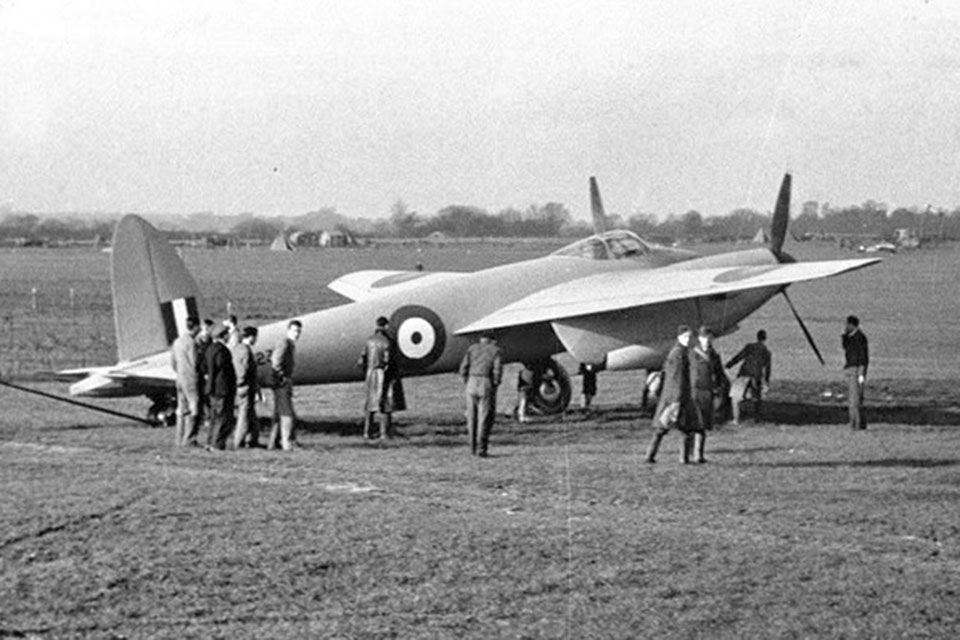
Still, it wasn’t easy for de Havilland to convince the Air Ministry that an unarmed wooden bomber faster than any contemporary fighter was the answer to Bomber Command’s needs. The obvious riposte to this too-neat theorization was that the enemy would inevitably develop faster fighters. The British could see what Germany had done in grand prix automobile racing and had no illusions about the country’s technological prowess. This proved to be true to a degree when advanced versions of the Fw-190 and the nitrous oxide–boosted Me-410 became operational, and absolutely true when the Me-262 twin-engine jet flew. But nobody had anticipated the mid-1940s plateau of propeller effectiveness and compressibility problems that would limit conventional fighters to speeds roughly equivalent to the Mosquito’s no matter how extreme their horsepower. The Mosquito was fast in 1940 and remained fast in 1945.
Nonetheless, the Mosquito’s speed was a slightly exaggerated characteristic of the airplane. When the prototype flew in November 1940, it was certainly faster than contemporary frontline fighters, and for 2½ years after that first flight the Mosquito was the fastest operational aircraft in the world. But it should be remembered that no Mosquito ever went as fast (439 mph) as that slick lightweight did. By the time the Mosquito became operational, in September 1941, there were a number of faster singles being readied or already in service—the F4U Corsair, P-47 Thunderbolt, Hawker Typhoon and, more to the point, Focke Wulf Fw-190, which became a particularly potent Mosquito opponent. Some late-model 190s had as much as a 40-mph advantage over Mosquito bombers. Mosquitos relied as much upon altitude as they did pure speed to evade attack. If they were bounced from above, their saving grace lay in putting the nose down, maneuvering and hoping there were clouds in which to hide.
Fortunately for the British, too few Me-262s were assigned to the air-superiority role, since Hitler wanted Schnellbombers. And for that, we can thank the Mosquito. When a single Mosquito flew a photorecon mission over Berlin in March 1943 and was fruitlessly chased by several Me-109s and Fw-190s, the Führer decided that, by God, he was going to have a fleet of superfast light bombers, and the 262 reluctantly accepted a role for which it was never intended.
Hermann Göring was another Mosquito fan. “In 1940 I could fly as far as Glasgow in most of my aircraft, but not now!” he famously said. “It makes me furious when I see the Mosquito. I turn green and yellow with envy. The British, who can afford aluminum better than we can, knock together a beautiful wooden aircraft that every piano factory over there is building….They have the geniuses and we have the nincompoops.”
Berlin was a frequent Mosquito target, for the airplane had the range to reach it and the heft to carry at first four 500-pound bombs and later as much as a 2-ton blockbuster bomb, and to do it at 35,000 feet. One famous three-plane Mosquito raid on Berlin in January 1943 was precisely timed to arrive just as Göring began an 11 a.m. radio address celebrating the Nazi party’s tenth anniversary. Sounds of confusion could be heard in the background as the broadcast was rescheduled for later in the day. At 4 that afternoon more Mosquitos arrived to again interrupt a radio speech, this time by Joseph Goebbels.
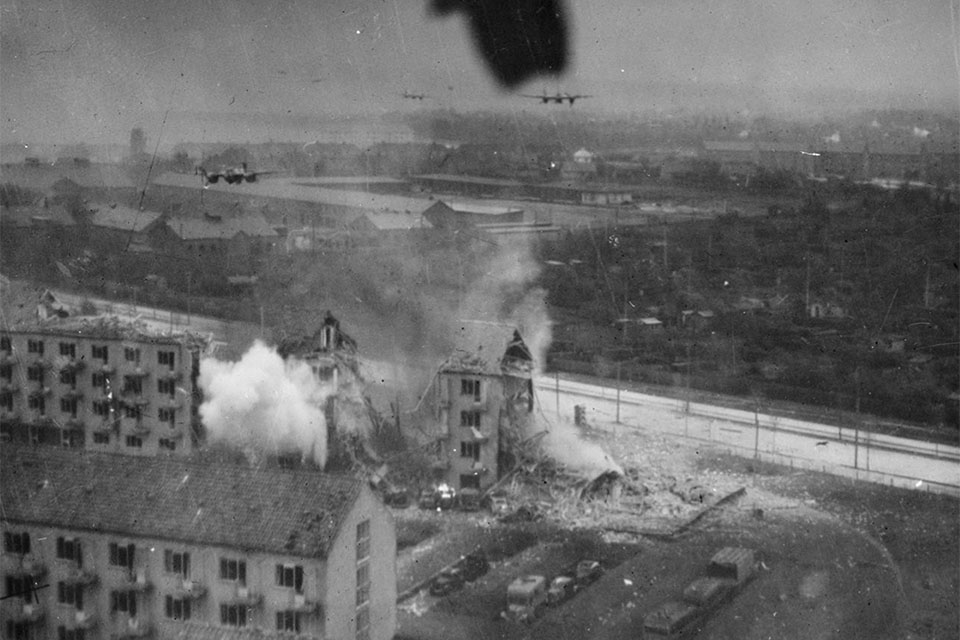
Though Mosquitos flew thousands of routine bombing missions, their most popular exploits were low-altitude, pinpoint hit-and-run raids, since the British media exploited them to the fullest. (The RAF smartly sent special camera planes along on some of the sorties to film the action.) With typical British understatement, they were called “nuisance raids.” Nuisance indeed: a four-aircraft attack on Gestapo headquarters in Oslo; a raid on the prison in Amiens that blew the walls to free 258 French Resistance fighters; six Mosquitos bombing an art gallery in The Hague that was packed with Gestapo records; raids on Gestapo HQ in the center of both Jutland and Copenhagen. (The press loved the fact that the Jutland raiders went in so low that one crew saw a Danish farmer in a field, saluting as they wailed by, and that during the Copenhagen raid the bombers literally flew down boulevards and banked into side streets.) Often the damage caused was light and collateral civilian losses were high—27 nuns and 87 children were killed in a Catholic school during the Copenhagen raid—but the effect on public morale was extreme. The Germans could run, but they couldn’t hide. Nobody was safe from the Wooden Wonder.
And why, exactly, was it wooden? Certainly because spruce, birch plywood and Ecuadorean balsa weren’t strategic materials and were in plentiful supply. Because furniture factories, cabinetmakers, luxury-auto coachbuilders and piano makers could quickly be turned into subcontractors. Because wood, particularly when covered with a thin layer of doped fabric, makes a remarkably smooth, drag-cheating surface free of rivets and seams. And battle damage could be repaired relatively easily in the field.
In April 1940, U.S. Army Air Forces General Hap Arnold brought to the U.S. a complete set of Mosquito blueprints, which were sent to five American aircraft manufacturers for comment. All were contemptuous of the British design, none more so than Beechcraft, which reported back, “This airplane has sacrificed serviceability, structural strength, ease of construction and flying characteristics in an attempt to use construction material that is not suitable for the manufacture of efficient airplanes.” Beech couldn’t have gotten it more wrong if they had tried.
Wood’s chief advantage is that it’s easy to work with and is a material that craftspeople have been shaping and hammering for millennia. It is sometimes assumed that a further benefit of wood was that it reduced a Mosquito’s radar signature, but with the short-range Luftwaffe night-fighter radar in use during the war, that doesn’t seem to have been a factor. A number of Mosquitos fell to He-219s and Me-410s in particular, perhaps because of the radar reflectivity of the big Merlin engines and their huge prop discs.
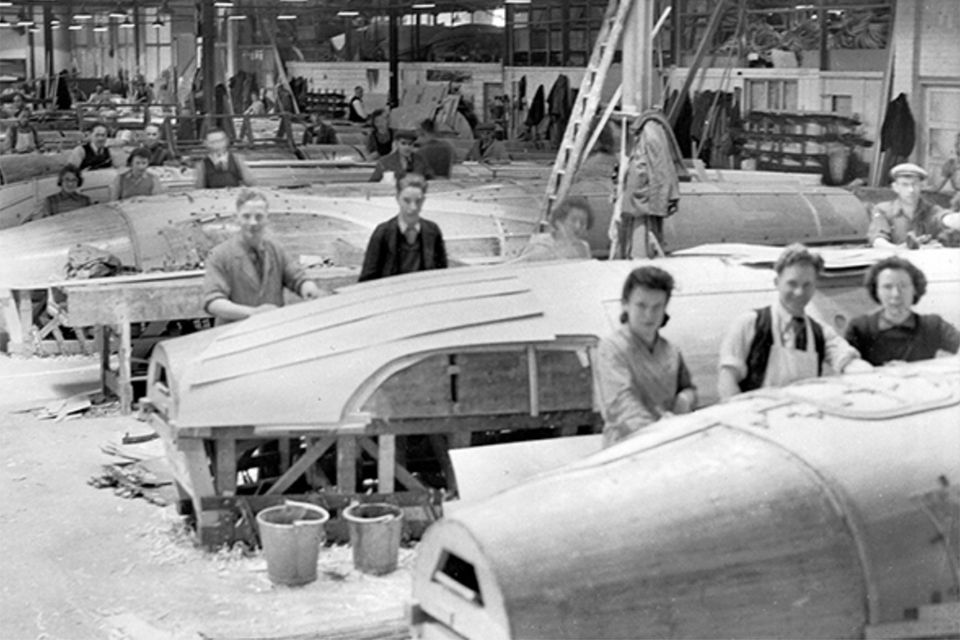
Wood is a composite, just as are the carbon/graphite-fiber materials used to make much of a Boeing 787 Dreamliner, and wood has the same qualities of strength, suppleness and light weight. Both wood and modern composites consist of tiny fibers suspended in a cellulose or polymer carrier—ingredients that by themselves have little strength but when combined create an extremely strong matrix.
Today composites are bonded under heat and pressure, but wood requires plain old gluing. Early Mosquitos were assembled using casein glues, which were exactly what you can buy today in any hardware store under the rubric “woodworker’s glue.” Casein glues are milk byproducts (which is why the most common brand, Elmer’s, has the familiar cattle-head logo), so they provide munchies for microorganisms, particularly when the environment is wet and warm, as was the case when the first Mosquitos were sent to Southeast Asia. In the Pacific theater, some Mosquito glues turned cheesy, and upper wing skins debonded from the main spar.
The solution turned out to be two-part urea-formaldehyde glue, which de Havilland began using in the spring of 1943. The urea glue was applied to one wooden surface and the formaldehyde catalyst brushed onto the other. When the two were clamped together, in some places with the simple pressure of tiny brass brads, a waterproof bond stronger than the wood itself was formed.
Mosquitos were internally coated with traditional marine varnishes, not nearly as waterproof as modern polyurethane coatings. So there were cases of Mosquito structural failures caused by simple wood rot—some among de Havilland of Canada–built airplanes, which were sometimes found to suffer from poorer workmanship and lower quality-control standards. A few Mosquitos—a total of 212—were also built in Australia, but that country had even bigger problems, with only a tiny cadre of aviation engineers and technicians to depend upon. The first 50 Australian-built Mosquito wings were so badly glued they had to be rebuilt.
The Mosquito was not an easy airplane to fly. As combat aircraft historian Bill Sweetman wrote in his book Mosquito, it was “a slightly nervous thoroughbred which could perform impressive feats in the hands of the courageous and competent…but would occasionally deal out a kick or a bite.” Its power-to-weight ratio and wing loading were both high, and its Vmc—the speed that needs to be maintained to assure rudder effectiveness with one engine feathered and the other running at full power—was, depending on load, an eye-watering 172 mph or more, probably the highest of any WWII twin. The much-maligned B-26 Marauder had a Vmc of about 160 mph.
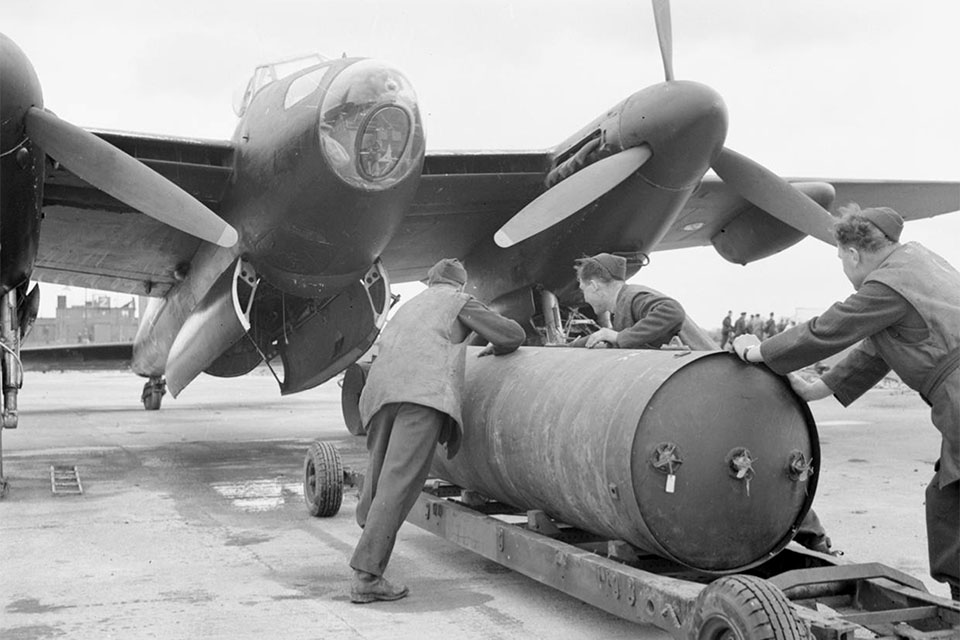
There was a substantial no-man’s-land between liftoff and Vmc during which an engine failure was usually fatal. Below Vmc, power had to quickly be retarded on the good engine to keep the airplane from rolling, and this meant a loaded Mosquito could no longer maintain altitude. (As cynics have said, the only reason to have two engines on a piston twin is so the good one can take you to the scene of the accident.) When their mounts were fully gassed up and carrying a 4,000-pound blockbuster, Mosquito pilots learned to ignore normal liftoff speed and instead keep the airplane on the runway no matter how long it was and pull up when they were just 200 yards or so from the end.
On takeoff, most multiengine airplanes exhibit little or none of the torque-roll/P-factor/slipstream-effect yaw of a powerful single, but a Mosquito’s engines needed to be handled carefully. The effect on yaw of the long, powerful outthrust engines was substantial. Leading with the left engine and opening the throttles judiciously helped, but Mosquitos didn’t have locking tailwheels to hold a heading during the first part of the takeoff roll. So a pilot had to use differential braking to catch takeoff swings, and in typical Brit fashion, a Mosquito’s pneumatic brakes were actuated by the rudder pedals but modulated by air pressure controlled via a bicycle-brake-like lever on the control column. Not a natural process.
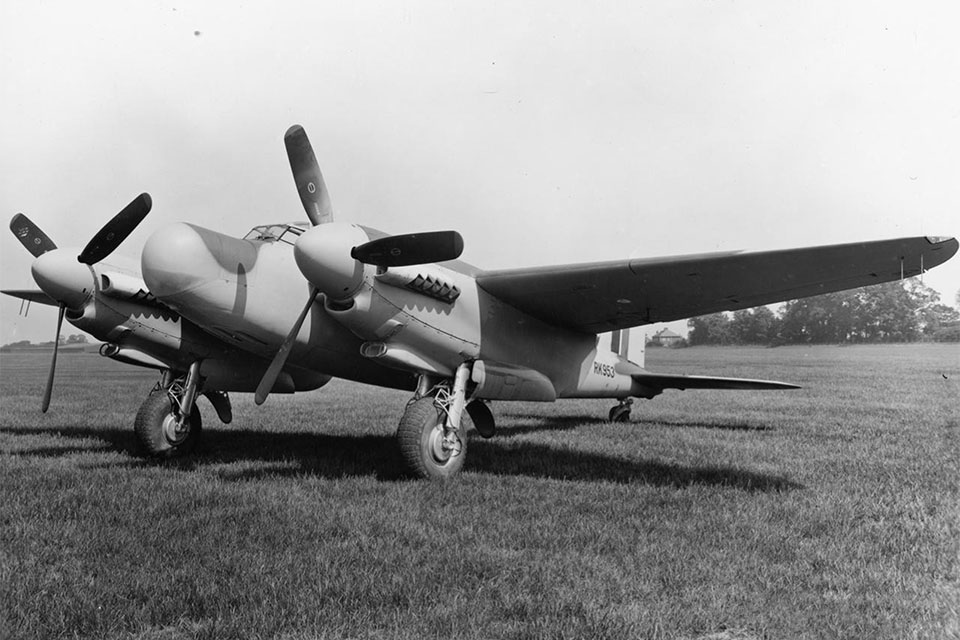
RAF Mosquito pilots were typically selected for their airmanship and experience, and they handled their Mosquitos with elite talent. The USAAF tried to operate 40 Mosquitos designated F-8 photoreconnaissance and meteorological aircraft, but they crashed many of them, some on the pilots’ very first Mosquito flights. (Granted, many of the crashes were due to mechanical problems.)
The F-8 program was a debacle, and in September 1944 it was canceled. It had been championed by Lt. Col. Elliott Roosevelt, FDR’s son, a low-time private pilot who had been forbidden to fly military aircraft. He trained as a navigator and loved the Mosquito because it let him fly as a crew member on missions over North Africa and the Mediterranean, which of course his unit’s Spitfires and F-4s—photorecon P-38s—couldn’t. Other Twelfth Air Force pilots weren’t so sanguine, and they wrote that “the Mosquito with low- and medium-altitude engines is useless for our purposes. With the Merlin 61 engine its usability has yet to be proven.”
Wright Field tested a Mosquito Mk. VII as part of the PR program and concluded it was “unstable in ascent at speed-of-best-climb. It was tail-heavy and unstable longitudinally during landing approach, especially with full fuselage tanks and center of gravity located near the aft limit, and rather precarious for inexperienced pilots to land in this condition.” The Pilot’s Flight Operating Instructions warned: “This airplane is NOT designed for the same manoeuvres as a single-engine fighter, and care must be taken not to impose heavy stresses by coarse use of elevators in pulling out of dives or in turns at high speed. Intentional spinning is NOT permitted. At high speeds violent use and reversal of the rudder at large angles of yaw are to be avoided….Tail heaviness and reduction of elevator control when the flaps are lowered is VERY MARKED….”
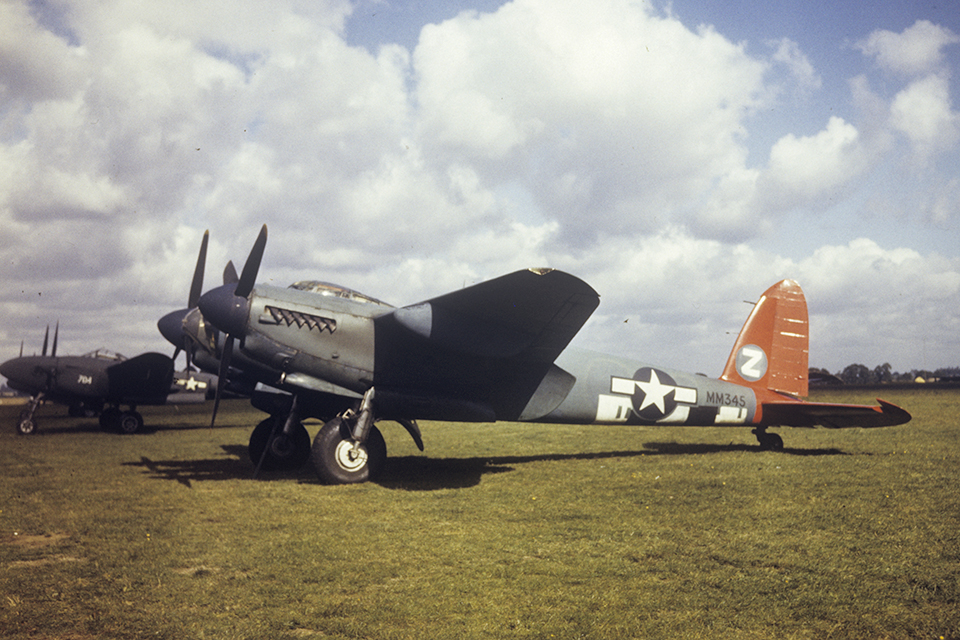
The Mosquito required unusually light control forces, and they remained light at high speeds. Many other fast aircraft were self-limiting; their controls heavied up at speed and made it hard for a clumsy pilot to pull the wings or tail off. Not so the Mosquito.
There were three basic branches on the Mosquito tree: bombers, fighters and photoreconnaissance types. Each had many variants, such as radar-equipped night fighters and bombers modified to carry 2-ton blockbusters. The bombers and photo planes were unarmed, while most of the fighters carried four .303 machine guns in the nose and four 20mm cannons under the cockpit floor, their receivers and ammunition-feed mechanisms extending back into the bomb bay. Fighter Command insisted that its Mosquitos be equipped with sticks rather than bomber yokes, despite the fact that pilots swore the yokes made the aircraft more maneuverable. The fighters are also easily recognizable by their flat windscreens, suitable for gunsights, rather than the bombers’ more aerodynamic vee screens.
There were Sea Mosquitos, though only 50 were built and the mark didn’t go into production until August 1946. Noted British test pilot Eric “Winkle” Brown did the original carrier-landing attempts, the first-ever multiengine aircraft carrier landings. Many were sure the shock of trapping would jerk the prototype Sea Mosquito’s tail right off, but the fuselage had been suitably strengthened. A far bigger danger was getting the Mosquito slow enough to make a reasonable carrier approach, and Brown knew he was flying on the back side of the power curve. The Mosquito had a vicious power-on stall that quickly snapped into a spin. “If we got low and slow on the approach it was going to be a fatality,” Brown later wrote, but he was able to hang the airplane on its props and get to the deck at just under 100 mph (a typical Mosquito approach was flown at 150 mph). As brave as Brown was, Indefatigable’s landing signal officer might have been braver. Photos of the first landing show “Paddles” standing on the centerline of the carrier deck, just ahead of the arresting cables. It was the only way Brown could see the LSO’s signals without their being obstructed by the left engine nacelle. Assumedly Paddles signaled “cut” and ran.
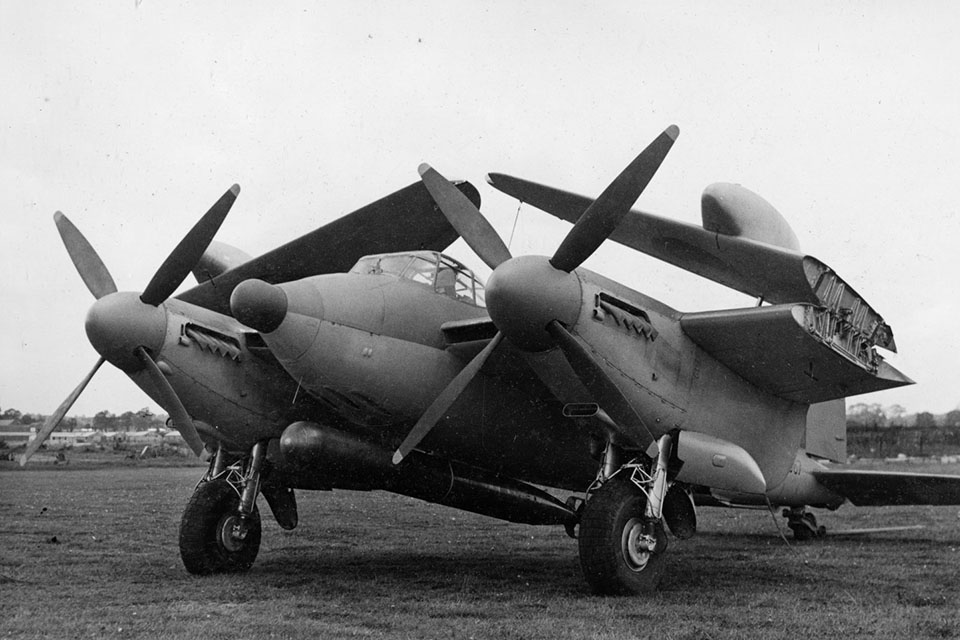
The biggest gun ever mounted in a Mosquito was a 57mm cannon called the Molins gun. It had a 25-round, rapid-fire ammunition feed designed and built by Molins, a formerly Cuban company that had become the world’s largest manufacturer of cigarette-making and -packaging equipment. The 75mm gun mounted in hardnose B-25G and H Mitchells was obviously larger, but it had to be manually reloaded by the bomber’s navigator, so its rate of fire was about one-sixth that of the Molins gun. Many doubted that the Mosquito’s structure could withstand the Molins’ recoil, but de Havilland needed just one day—the time it took the factory to saw the nose off a crashed Mosquito, mount the 12-foot-long gun and test-fire it—to prove them wrong. The barrel recoiled 18 inches and hosed out a gout of flame 15 to 20 feet long, but the wooden airframe was flexible enough to dampen the shock.
Mosquitos that carried the Molins were called “Tsetses,” after the deadly African fly. Their specialty was sub-hunting in the Bay of Biscay. The bay was so shallow that the German subs had to dash across while surfaced, and Tsetses picked off enough of them that soon the subs could only travel at night. Tsetses also destroyed more than a few Luftwaffe aircraft, and the effect of a 57mm projectile on, say, a Ju-88 was devastating.
Another unusual weapon was the Highball, a Mosquito-size version of Barnes Wallis’ famous Dambuster bouncing bomb. It was developed for use against Tirpitz, the German battleship hidden away in a Norwegian fjord. The Highball was to be spun up in flight—two were carried in the open bomb bay of each Mosquito—by power from a ram-air turbine, which must have been one of the first-ever uses of a RAT. Highballs would be dropped at very low altitude to bounce over the torpedo netting that protected Tirpitz and then crawl down the hull to explode well below the waterline.
Lancasters dropping 6-ton Tallboy bombs got to Tirpitz first, so the Highball airplanes and their weapons were sent to Australia to fly against the Japanese. Unfortunately, endless arguing about how the British carrier force should cooperate with the Americans who were running the Pacific War kept the Highballs hangared until war’s end, and they were ultimately destroyed as “secret weapons.”
The biggest postwar user of surplus Mosquitos was the Nationalist Chinese Air Force, which bought somewhere between 180 and 205 of them from Canada. But the Chinese pilots wrote them off at a rapid rate, ultimately destroying 60 of their Mosquitos. One was made into a nonflying taxi-trainer by locking the landing gear down and installing a network of bracing tubes between struts and fuselage, though the Chinese managed to crash even that one.
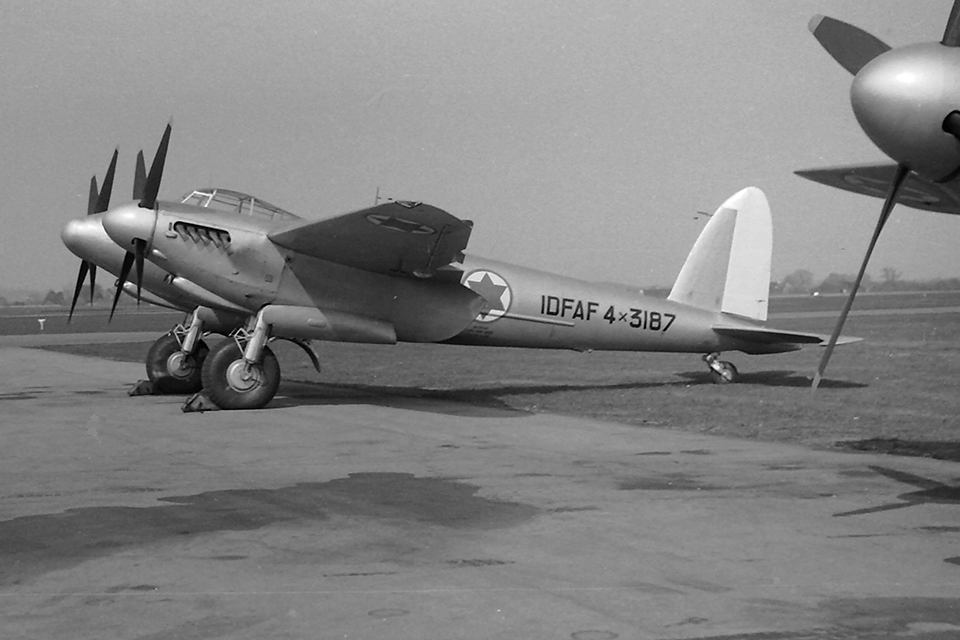
It’s hard to tell how many Mosquitos the Israeli Air Force operated, since their procurement methods in the late 1940s and early ’50s were so secretive, but they eventually may have had as many as 300. Those that flew operated mainly as photorecon aircraft, allowing the Israelis to snoop freely on their Arab neighbors. Despite the fact that the various Arab air forces were re-equipping with MiG-15s and the like, not a single IAF Mosquito was ever shot down, though repeated attempts were made to intercept them. The Mosquito’s combat career ended during the Suez Crisis, in 1956.
Exactly 7,781 Mosquitos were built, the last one on November 15, 1950; 6,710 of them were delivered during WWII. The Mosquito outlived its supposed successor, the wood-and-aluminum de Havilland Hornet, by several months of RAF service. A new, larger, Merlin-powered Mosquito Series 2 airframe had been planned but never built, and the conceptualized “Super Mosquito” suffered the same fate. The Super Mosquito was to have been powered by 24-cylinder Napier Sabre engines, with a crew of three, an 8,000-pound bombload and an estimated maximum speed of 430 mph.
In 1951 the Mosquito was finally replaced by the English Electric Canberra, a gunless 580-mph jet that was designed to fly fast and high enough to evade all pursuers. Sound familiar?
For further reading, contributing editor Stephan Wilkinson recommends: Mosquito, by C. Martin Sharp and Michael J. F. Bowyer; Mosquito: The Original Multi-Role Combat Aircraft, by Graham M. Simons; and Mosquito, by Bill Sweetman and Rikyu Watanabe.

